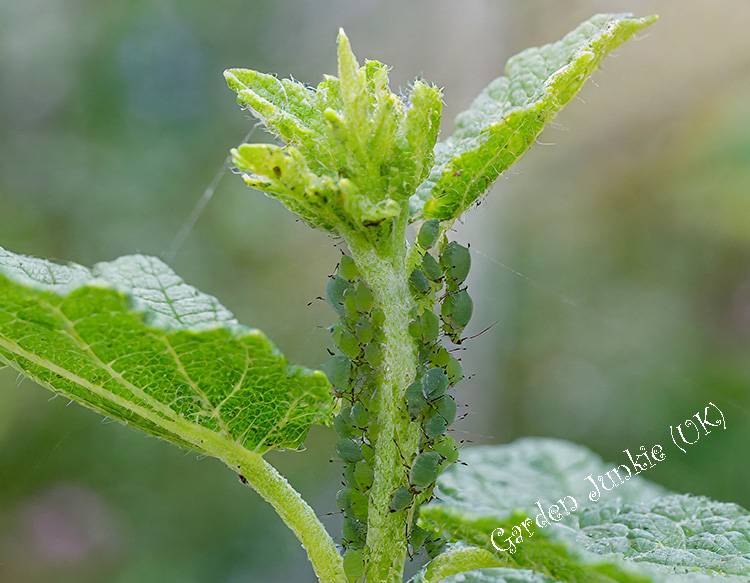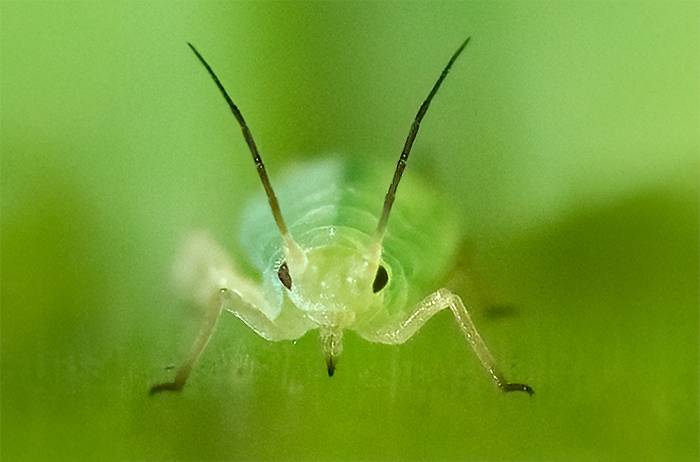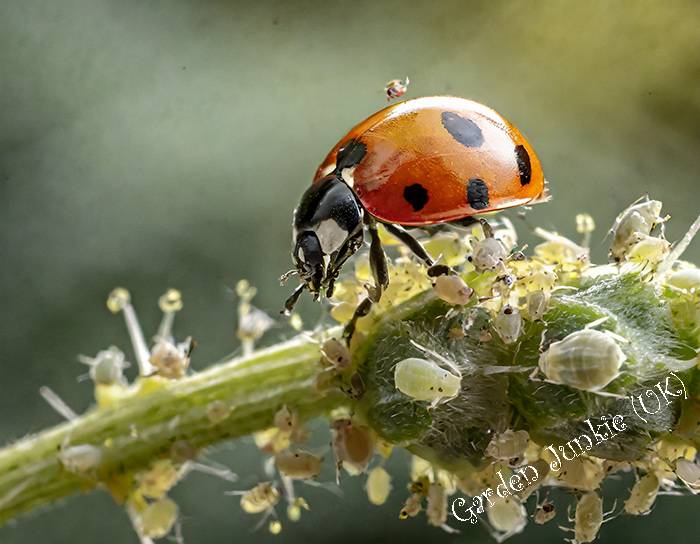Beautiful Plants For Your Interior

Green Aphids
In Britain, there are over 500 species of aphids. While some are limited to one or two plant species, others have a broad range of plant hosts. Virtually any type of plant, including ornamentals, vegetables, fruits, greenhouse plants, and houseplants, can serve as a host for aphids.
The Green Aphid also known as the greenfly aphid and or rose aphid is a tiny but mighty garden pest. They are small sap-sucking insects and members of the superfamily Aphidoidea. These soft-bodied insects, measuring around 2-3mm in length as we shall see below are surprisingly common throughout the gardens of the UK and beyond.
Green Aphids: A Life Cycle
Here’s a closer look at their key features:
Appearance
- Pear-shaped body with long, slender antennae.
- Typically bright green, although they can vary in colour to yellow, pink, or even red.
- Look closely for two short tubes (cornicles) projecting from their rear end
Habitat
- Green aphids are opportunistic feeders, infesting a diverse range of plants. Think roses, beans, peas, lettuce, tomatoes, potatoes, peppers, and many more!
- They have a particular fondness for tender, succulent growth, often congregating on new leaves and buds.
- You can find them both indoors and outdoors, so vigilance is key.
Behaviour
- These pests don’t chew; they pierce plant tissues with their sharp mouthparts and suck out the nutritious sap.
- They reproduce rapidly, forming large colonies that can quickly overwhelm your beloved plants.
- Be warned, they leave behind a sticky calling card – honeydew. This sugary substance attracts other unwanted guests and encourages the growth of sooty mould, further harming your plants.
- As if that wasn’t enough, green aphids can also act as disease carriers, spreading harmful pathogens among your greenery.
Additional Notes:
- While wingless aphids are the norm, winged individuals can appear when populations get out of hand, allowing them to spread their mischief to new plants with ease.
- Remember, “green aphid” might be the common name, but there are other green aphid species with slightly different characteristics and preferred hosts. So, accurate identification can be helpful when choosing control methods.
Identification
Recognising green aphids is crucial for taking effective action against them.
Here are some more key features to help you identify them:
Size
- Around 2-3mm long, making them quite small and easy to miss at first glance.
Colour
- While primarily green, variations in colour are possible, including yellow, pink, or even red.
Markings
- Look for a pear-shaped body with a distinctly darker head.
- Two short, blunt tubes (cornicles) project from the rear end, which are easily visible under magnification.
- If you can examine the antennae under magnification, which are long and slender, you will see they are usually comprised of 6 segments.
Unique Characteristics
- Their presence is often revealed by the presence of the sticky honeydew on leaves and stems as mentioned above.
- Look for crowded clusters of aphids gathered on new leaves, buds, or undersides of leaves.
- Winged individuals may be present, especially when populations are high, facilitating their spread to new plants. These have transparent wings that extend beyond the body.

Green Aphids: Green Aphid, Where You Can See The Sharp Piercing Mouth Piece Used For Sap Sucking
Damage
Direct Feeding
- Their primary weapon is their piercing mouthparts. They insert these into plant tissues, especially new leaves, buds, and tender shoots, and suck out vital sap. This weakens the plant, hindering its growth and development.
- Imagine this sap-sucking frenzy happening on a large scale, with entire colonies of aphids feasting on your plants. The consequences can be severe, leading to stunted growth, wilting, and even plant death.
Honeydew Havoc
- As they feed, green aphids excrete a sticky substance called honeydew as we have mentioned earlier. While it might sound harmless, it’s anything but.
- This sugary liquid creates a perfect breeding ground for sooty mould, a black fungal growth that covers leaves and stems.
- Sooty mould not only looks unsightly but also blocks sunlight, further impacting photosynthesis and harming the plant’s ability to produce food.
Disease Transmission
- Unfortunately, green aphids can and often do act as tiny disease carriers. As they move from plant to plant, they can unknowingly transmit harmful viruses and pathogens.
- This can lead to a range of plant diseases, depending on the specific virus or pathogen involved. The symptoms can vary but often include leaf discolouration, distortion, and even complete plant collapse.
Additional Consequences
- Aside from the direct damage to the plant itself, green aphid infestations can also attract other unwanted pests, such as ants attracted to the honeydew.
- The overall health and aesthetics of your garden can suffer significantly due to their presence.
Lifecycle
Understanding the green aphid’s lifecycle is crucial for predicting outbreaks and implementing effective control strategies. Here’s a breakdown of their cycle.
Egg Stage
- In colder climates, green aphids overwinter as hard-shelled eggs deposited on woody plants like roses.
- They may reproduce year-round in warmer climates or greenhouses without needing an egg stage.
Nymphal Stage
- Eggs hatch into nymphs, miniature versions of the adults without wings.
- These nymphs grow and shed their skin several times (moulting) as they mature.
- Development time from egg to adult can be short under favourable conditions, allowing for rapid population growth.
Adult Stage
- Eggs hatch into nymphs, miniature versions of the adults without wings.
- These nymphs grow and shed their skin several times (moulting) as they mature.
- Development time from egg to adult can be quick under favourable conditions, allowing for rapid population growth.
Generations
- Throughout the growing season, multiple generations of parthenogenetic females can occur, leading to exponential population growth.
- In late summer or autumn, when conditions become less favourable, sexual reproduction may occur. Winged males and females develop, mate, and lay eggs on woody plants to complete the cycle.
Key Points
- The rapid reproduction rate and short development time allow green aphids to quickly build large populations.
- Winged forms facilitate their spread to new plants, exacerbating infestations.
- Understanding the different stages and their timing is crucial for choosing the right control methods at the most effective time.
By being informed about the green aphid’s lifecycle, you can proactively protect your garden from its harmful effects.
Control Methods (Organic)
Don’t despair! Even without harsh chemicals, you can combat green aphids and protect your garden naturally.
Here are some effective organic methods:
Organic Methods: Natures Warriors
- Ladybirds, lacewings, and hoverflies: These friendly predators love to feast on aphids. Attract them by planting herbs like dill, fennel, and coriander, or purchase ladybirds and release them directly onto your plants.
- Minute pirate bugs: These tiny assassins devour aphids with gusto. They’re naturally present in gardens, but you can encourage them by providing undisturbed areas with leaf litter and mulch.
- Parasitic wasps: Tiny wasps lay eggs within aphids, turning them into aphid mummies. Encourage them by providing flowering plants like alyssum and dill.
Encourage Beneficial Plants
- Companion planting: Interplant your aphid-prone plants with herbs like catnip, chives, garlic, and nasturtiums. These release scents that repel aphids and attract beneficial insects.
- Trap crops: Plant sacrificial crops like nasturtiums or lettuce away from your main plants. Aphids will be drawn to them, allowing you to easily remove them without harming your desired plants.
Direct Action
- Handpicking: Put on your gloves and carefully remove clusters of aphids by hand. Drop them into soapy water or squish them gently.
- Strong blasts of water: A forceful spray of water can knock aphids off plants and disrupt their colonies. Repeat regularly to keep populations in check.
- Insecticidal soap spray: Made from natural ingredients like fatty acids, this insecticidal spray coats and suffocates aphids on contact. Be sure to use a certified organic brand and follow application instructions carefully.
- Neem oil spray: Derived from neem tree seeds, neem oil disrupts aphid feeding and development. Again, opt for an organic brand and use it according to label instructions.
Create an Unwelcoming Environment
- Keep your garden clean and tidy: Remove weeds and debris where aphids might overwinter or hide.
- Encourage healthy plants: Strong, well-nourished plants are more resistant to pest attacks. Ensure proper watering, fertilisation, and appropriate sunlight for your plants.
- Improve soil health: Healthy soil fosters a diverse ecosystem that naturally supports beneficial insects and helps keep pest populations in check.
Remember
- Persistence is key! Organic methods often take longer than chemical controls, so be patient and consistent with your chosen method.
- Combine different techniques for a more comprehensive approach.
- Monitor your plants regularly to detect infestations early and intervene promptly.
By embracing these organic methods, you can protect your garden from green aphids while supporting a healthy and balanced ecosystem.

Green Aphids: Natural Green Aphid Control, Encourage Beneficial Insects Like Ladybirds to Feast on Aphids
Control Methods (Non-Organic)
While organic methods are admirable, sometimes infestations require a stronger approach. However, it’s crucial to emphasise safe and responsible application with non-organic methods. Here are some options to consider, but always prioritise organic methods when possible:
Insecticidal Sprays
- These readily available insecticidal sprays contain chemicals that disrupt the aphid’s exoskeleton, causing dehydration and death.
- Benefits: Quick action, relatively safe.
- Drawbacks: Not persistent, requires thorough coverage, and effectiveness diminishes in hot and wet weather.
Neem Oil
- Derived from neem tree seeds, this oil disrupts aphid feeding and development. Choose organic neem oil products and follow label instructions carefully.
- Benefits: Relatively safe for beneficial insects, has some repellency effect and can control other pests besides aphids.
- Drawbacks: Requires multiple applications for maximum effect, has an odour some find unpleasant, and may harm sensitive plants.
Synthetic Insecticides
- These powerful chemical sprays offer broad-spectrum pest control, including aphids. Use them as a last resort and only after carefully considering the risks and alternatives.
- Benefits: Offer quick and potent control, available in various formulations for different application methods.
- Drawbacks: Highly toxic to beneficial insects (ie.. Ladybirds), harmful to pollinators, can pose risks to human health and the environment and may lead to insecticide resistance.
Remember
- Before using any non-organic method, carefully read and follow all label instructions, paying close attention to safety precautions and application rates.
- Target application specifically to infested areas to minimise harm to beneficial insects and other non-target organisms.
- Consider the environmental impact of your choice and prioritise selective options over broad-spectrum insecticides.
- Always prioritise organic methods whenever possible. Non-organic methods should be a last resort and used responsibly with a full understanding of the potential risks and alternatives.
By following these guidelines and choosing the least harmful option necessary, you can control green aphids while minimising negative impacts on your garden’s ecosystem and your health.
Keep Your Garden Green and Aphid-Free!
Prevention is always better than cure, and the same applies to green aphids. By taking proactive steps, you can create a garden environment less susceptible to these tiny terrors.
